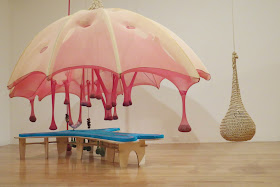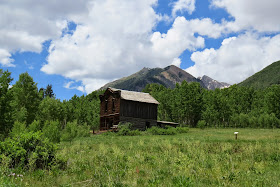When we arrived, there were a couple at the springs already, tending to one of the pools that have been built up on the edge of the river to capture the steaming water that exits from the creekside nearby. When we visited, the springs were exiting from fissures in the rock a little above the waterline; however in spring, when snowmelt is at its highest, the pools are flooded and often the rock walls built up over the summer are washed away. Each summer, as the water level drops and exposes the springs, the pools have be reconstructed to make them comfortable.
I guess the pools hadn’t been used much yet this season, as when we arrived, the pool had a dangerously hot stream of water on one side, and a freezing torrent rushing in from the river on the other side. With the help of a more experienced local guy we reconstructed the pool by blocking most of the cold water ingress and allowing what was left to properly mix with the hot spring water before it entered the pool. It is important to get the mixing right, as the water that comes from the spring is hot enough to burn you extremely quickly. After a bit of work we could enjoy a hot, but comfortable pool, watching the fast river flowing by to our side, with the red rock mountains in the background. By the time we left, others had arrived and were enjoying our hard work.
We left in the afternoon and drove back up the 133, turning east at Carbondale and driving to Aspen on the 82. I suppose it was predictable for such an expensive town, but almost every street in Aspen is subject to parking restrictions, most of which require you to pay if you wish to stay more than 2 hours. In addition, there are no RV parks anywhere near the town. I guess that the intention is to prevent vagabonds like us from flooding into the town, lowering the tone of the neighbourhoods, and abusing the excellent free services available. Sadly for them we were not dissuaded so easily, and after a bit of exploration we found a street on the southeast side of town that offered free parking from 6pm to 8am, and parking for the rest of the day for $8. I would normally have continued searching, but for $8 we got access to an extremely fast unsecured Wi-Fi connection courtesy of a luxury apartment/hotel complex next door.
If you have bulging pockets, Aspen is an excellent place to spend your money, but for people of more modest means like us, there are plenty of opportunities to enjoy yourself in Aspen without spending much money. Aspen certainly doesn’t have the relaxed, frontier town feel of some of the other mountainous historic towns that we’ve visited in Colorado, but there are some beautifully landscaped parks, a number of well maintained walking trails into the surrounding mountains, and a constant stream of free(ish) events. A mark of the wealth in Aspen, was the fact that the public toilets in the park have been designed by an architect, and are nicer than many American's homes!
Whilst we were in Aspen we visited a free contemporary kinetic/immersive art exhibition, a free funk concert in the nearby ski resort of Snowmass (connected by a free shuttle bus), and enjoyed listening to a classical performance at the permanent concert tent adjacent to the Harris Concert Hall. For most of the summer Aspen has a classical music festival; the larger performances are all in the tent and the adjacent concert hall, and for the higher profile performances there is a charge. Fortunately the tent has sides which are left almost entirely open, and any cheapskate like us, can sit on the grassy mound outside and enjoy the performance without paying.
Once up in the mountains we took the opportunity to visit the nearby abandoned mining town of Ashcroft, high in the mountains in the White River National Forest.
On our second and third nights in Aspen we parked on Lone Pine Road, one of the few roads in town without expensive parking restrictions, where you are allowed to park for 72 hours without paying. I’d be willing to take bets that there is a local parking clause preventing you from sleeping in your vehicle, but nobody checked and we were left alone. On the morning that we left Aspen, I noticed an unusual hissing sound coming from the engine from the moment that we pulled out of our parking space. It sounded too quiet to be a problem with the compressed air braking system, and so I guessed that it’d be a problem with the air intake or exhaust system. Within a few hundred meters, an MR (engine) fault light had come up on the dash, and it was clear that we were well down on power. I found a quiet place to pull over and began to plan what to do next.
The computer on the dash display will tell me which module has identified the problem, but this will only direct me to the problem, it does not give me the specific fault code and so I cannot identify the cause. To give me a better idea of where to look, I first plugged the Mercedes Xentry diagnosis computer into the truck, and pulled up the current fault codes. The problem was immediately identified as being with the boost pressure from the turbo, and the diagnosis software linked to the relevant WIS (workshop information system) page to help me identify the high pressure elements of the air system, and where they might be leaking. I realised that there was little I could do without tilting the cab, and so I undid the eight internal retaining bolts, and pumped the manual hydraulic pump to push the cab forward on its mounts.
A UK plated ex-Brinks Mercedes truck, is never going to blend in on an American road, and we regularly engage in similar conversations about what the truck is, how it got to wherever it is parked, and what we are doing. Despite the repetitiveness, I actually don’t resent having these conversations. I love talking about travelling, and am extremely proud of the truck that I converted. Whilst the sight of the truck may sometimes pique someone’s curiosity, it does not always intrigue them enough to come and talk to us. Predictably though, having the cab tilted forward was too much for most people, and almost everyone that walked past tried to start a conversation enquiring about the truck. Whilst I am normally more than happy to talk shop, I was less talkative on this occasion. You would have thought that most people would guess that a man covered in grease, surrounded by tools, and up to his chest in an engine bay, would not be in the mood for a chat, but this wasn’t the case, and I directed most people’s queries to Naomi.
Unlike older normally aspirated diesel engine, modern turbo diesels have a relatively complicated air intake system. New vehicles with complex exhaust gas recirculation systems would undoubtedly be beyond my comfort zone, but I can understand reasonably well how the system on Jim works. The air enters the filter housing, where it is cleaned; from there, the air passes through the turbocharger, which uses the pressure from the exhaust, to spin a turbine and increase the pressure of the air. This effectively forces the air into the engine, rather than relying on suction from the combustion process. Out of the turbocharger, the air passes through an intercooler, which uses a heat exchanger to cool the air, which had been heated up when passing through the hot turbocharger. From the intercooler, the air is sent to the air intake manifold of the engine and into each piston to enable combustion.
With the cab tilted, it was immediately obvious what the problem was; I would have easily spotted it without having first checked the computer diagnosis. The hose that links the intercooler to the air intake manifold at the top of the engine had become disconnected at the engine end. This meant that most of the boost pressure from the turbo was being lost, and the engine was operating largely as a normally aspirated engine. Thankfully the proprietary clamp which holds the hose to the manifold had merely worked loose, and had not fallen off, allowing me to reconnect the hose, and retighten the clamp to rectify the problem. The bolt on the clamp is undoubtedly metric (probably M8), and even if only that had fallen off, I would surely have had an awkward task finding a replacement in a country where an inch is still the smallest whole unit used.
I took the opportunity of having the cab tilted, to do a brief inspection of the engine and ancillaries to check that no other problems were imminent. I cleaned the prefilter that prevents bigger debris from reaching the fuel filter, and cleaned the worst of the dust off of the engine. During my inspection I noticed that one of the exhaust manifold studs had snapped off. Each of the six exhaust ports has two bolts holding the manifold to the engine block, and the heat cycles at the back of the engine had caused one of the bolts on cylinder six to shear off. There was some visible blackening around the exhaust port in question, and so it was clear that some of the exhaust was leaking around the gasket. The noise of the engine has not changed dramatically during the last 15,000 miles and so I don’t suppose it is leaking much air, but it needs fixing. The reduction in exhaust pressure will be stopping the turbocharger from generating full boost, and is allowing exhaust fumes to be where they shouldn’t.
Pulling the exhaust system apart, and extracting a snapped stud with 11 years of rust holding it in the block, is not something that I could realistically do by the side of the road. I returned the cab to the driving position, and left the exhaust stud problem until I could visit a suitably qualified garage. The MR fault cleared as soon as I started the engine, and we got back on the road, with engine power restored. We left Aspen headed east on Highway 82, in the direction of the 3,700m high Independence Pass.









No comments:
Post a Comment